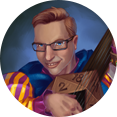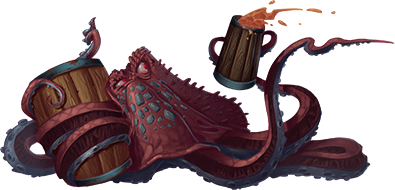Welcome to Hobby DM! This is a series I’ll be running over time that focuses on how to DM and prep for your everyday individual. No end of material exists that zooms in on running the game from the perspective of someone with tons of time to prep their game. Certainly, if many of us had the ability, we would focus entirely on tabletop RPGs (TTRPGs) all day. I would love to get lost in the worlds of my creation all week, but the reality for most of us is that running a TTRPG is just part of who we are. You may have a job, charity work, family, or other commitments that you must tend to regularly. This series is for you, the person who just wants to run a game for your friends or family.
My Intention with this series is to help the everyday person run their games successfully while holding down their standard lives.
This series will cover some differences that can come up between running a game for an audience as opposed to one for your friends. Setting a difference between games for entertainment of others and games for entertainment of the players is an important precedent to acknowledge. For seasoned veterans that have run the game for years, perhaps you’ll be able to get some new ideas from it. For those that are new to the hobby, welcome and I’m ecstatic that you’re considering running a TTRPG for your friends. Now, let’s get on with this.
Imagination as a Stage
The concept of Theatre of the Mind is entirely not new. It harkens back to radio terminology when The Lone Ranger and similar shows would be broadcast across the waves and into your home for you, the listener, to enjoy. All manner of techniques would be used, including descriptive storytelling, sound effects, onomatopoeia, and dialogue in order to create an image for the listeners. If that rings with some familiarity, then you have seen why the term made the hop to the TTRPG realm.
Telling stories without the ability to put a visual aid in front of people is a tool as old as language itself. The application of those techniques to enhance your game may be new to you, so let’s talk about some key benefits that Theatre of the Mind (TotM) can bring to a Hobby DM:
Cutting down prep time is absolutely one of the biggest desires I have heard from other Hobby DMs. Therefore, many people run pre-made modules as they do a lot of the prep work for you. I enjoy pre-made modules, but I find running homebrew campaigns to be a more satisfying experience. That means I need to cut down on the time spent in “the lab” each week. TotM can take some of that time you would have spent preparing gridded combat, maps, or tokens and give it back to you to spend how you wish.
You Walk Into the Tavern
Theatre of the Mind is a process by which you describe a scene without using imagery. It can be something simple like describing the patrons of a tavern, to anything as complex as describing large army movements across a battle. The strength in the process is in its scalability. Using the process comes in the way you describe your surroundings.
The best way to think about playing with Theatre of the mind is that it is more of a method than a style of play. What I mean by that is that you begin to understand a process when you run something using no imagery. There are definable steps, which I will cover, that you can walk through to set a scene to your players. Once you understand the machinery of setting a scene and running combat, it can be worked into a semi-rigid set of steps that still allow for the unexpected.
To really lean into the strengths of TotM you have to first accept that method into your own mindset. The first person you should describe a scene to after getting it down is yourself. Be picky and honest with yourself. If you feel like the word choice isn’t there yet, ponder it over while you’re on your commute or making dinner. I spent many hours on my drives to and from work describing fantastical settings to myself, either in my head or out loud. It’s my car, I can talk to myself if I want!
Making the Concept Useful
How and when to use Theatre of the Mind is a question that can be asked in two distinct parts. My feeling is that TotM could be used to great effect in exploration as well as combat, but you may feel differently at your table. It’s important to remember that not every table will behave the same with running TotM as a permanent method.
A place where the method can really shine in exploration would be in scenes that are too intricate or specific to find a map for. If you have the perfect vision for what this monster’s lair might look like or exactly what a cartographer’s office may be, then you either have to make a map or employ TotM. I would argue that the latter is a much better method as it lets you get into as much detail as you want to put in.
Another situation would be when a scene is far too grandiose to display on a map. An outstanding example of this in my mind is Castle Ravenloft in Curse of Strahd. Certainly maps exist to the massive complex, but when it is described it can end up feeling like the larger-than-life castle that it is meant to be. Perhaps the party comes across a glittering ice gulch that stretches for miles with a massive bridge that spans it carved out of the very ice in the gulch. These kinds of massive environments can gain a lot by being described, but not directly shown.
Use the player’s imagination to enhance your own atmospheres. They will often picture something much larger than you could show on a map.
In combat, dynamic fights are where you can really lean into TotM. If the scene evolves throughout combat, that can be difficult to convey with a map. Say, for example, you were fighting on top of a giant slab of rock sliding down an avalanche. That is an evolving landscape that could be very difficult to convey the epic scale that you would like in a situation like that. Or another would be an Indiana Jones like rail cart fight. There is a massive amount of dynamism to be unlocked when only using your imagination.
Large combat can be especially cumbersome in D&D if you are using a grid. This may involve turn after turn without the players getting to interact at all. Theatre of the mind can sum up those actions into a few sentences and allow the immediate combat to keep flowing for your group. In addition, it allows you to focus the metaphorical camera exactly where you want. You could slide some small fights into the background when the enemy’s cave troll barrels onto the scene. On a grid, the players may feel the need to clean up smaller enemies, but in TotM you can just let them fade into the backgrounds.
Setting the Scene
We’re going to break down the process into two distinct roles that you must inhabit to successfully run Theatre of the Mind. Those two roles are exploration and combat and they are worlds apart in your aim and method. I’ll cover each individually, starting with exploration.
During the exploration phase, you are playing the world. I’ve always thought about it as if I am the place that they’re exploring. I reveal the secrets that I might have piece by piece. I don’t just give them everything at once. If you consider yourself to be the place that you are trying to convey, then the act of exploration becomes a conversation. When you consider exploration a conversation with someone you have never met before, then you can identify the pieces of exploration and how they will flow.
Start with the big details, the very broad strokes. Picture this like the introductions to your conversation. You tell them the things that you want them to see. Tell the party about the giant Rakshasa statue dominating the far wall and the river of glimmering water that pours in from a sunlit hole above it. Give them the details of the space that are reasonable to notice on a first glance.
Bonus Tips
Learn and use transitive descriptors when you’re describing settings. Phrases like “flowing from” and “rising above”. These will help put objects together in relation to one another. Another helpful habit is to tell the players how their character’s body reacts to the scene. Consider using phrases like “Your nose crinkles at the smell of mold and mildew” or “Your eyes struggle to take in the size of the glowing crystalline structure in front of you.” Telling a player how their character’s body reacts to a scene can aid them in picturing it.
An important side note I’ll make here is to not get stuck on the visual. It’s completely natural to get stuck on the description of what the party sees, but we have 5 senses and you should try to engage at least a few of them with each description. Work in descriptions of the smell of a location. Is it the freshly clipped lavenders in the vase on the desk or the subtle scent of rust from the destroyed iron golem on the floor? Tell them about sounds that they might notice, like a tree scratching against a window. Give them the feel of their skin. Does the room make their hair stand on end or fill them with foreboding?
After your initial description, give the party time to ask questions and let them learn more and more in the conversation. When they ask to look at something, peel back a layer and tell them about it in more distinct detail. It’s totally fine to shut down a question if they are barking up the wrong tree. For example, if they focus too heavily on a chair, it’s fully okay to tell them “This looks like a regular chair with nothing special about it.” You’re not hurting the conversation, you’re just keeping it on topic. During this phase you should move your phrasing to match the more detailed look the characters are taking. Move from saying “junk covered desk” to “The desktop is a mishmash of papers, empty alcohol bottles, and stains.”
After Initiative
Moving into combat, your role shifts significantly. You should no longer whimsically consider yourself “the place” and instead switch into a utilitarian mode. You are now the only link to visual space that the players may have. This means that you need to be clear and concise in your communication. It is tempting to wax poetic about the things happening in combat, but you need to make sure that your information is clear. You can still be descriptive at this time, but the point of the description needs to be obvious. An example, telling the party that the fireball the wizard threw ignites the robes of the cultist who crumbles forward into a mess of charred meat on the floor. You should end a descriptor like that with the point of it, consider adding “He is dead.”, to the end. This helps the flow of information remain open and clear. Your goal in combat is to communicate often and precisely during Theatre of the Mind.
One of my preferred techniques for keeping spatial awareness on the battlefield is the concept of melee, near, and far.

Melee

Near

Far
Using these three distances and making them a standardized unit can help with communication at the table. You should inform the players of these terms and let them get used to hearing them and knowing what they mean. The goal is to get to where you can just say “The bugbear is near Julip.”, and Julip’s player can know that that means they can get there in a turn. You can tack on things like very far and extremely far, but these are often unnecessary and may overcomplicate the system.
Moving on from distance, another useful tool in your Theatre of the Mind toolbox should be the top of the round summary. The top of the round summary refocuses the combat and allows players a chance to catch up if they zoned out for a few. I really enjoy these as it lets you refocus the action to important focal points. It runs exactly as you think it would. At the top of the round, summarize the current state of combat. If you need some help to form a summary, here are some key questions to answer during it:
-
Who is in melee range of who?
-
What condition are the enemies in?
-
What condition are the player characters and allies in?
-
What looks dangerous right now?
-
What is unclear right now?
-
Where is something important?
You may not have an answer to these questions, and that is totally fine. Just leave out what you don’t need to cover and move on to the next topic. I find that if I offer a summary at the top of the round in a brief format with a focus on utilitarian information, players have a better sense of the battlefield. I have even taken to doing these during grid combat as I found them so helpful.
I mentioned this earlier, but just because your role is more utilitarian this time doesn’t mean that you have to leave out all descriptors. Part of the joy of Theatre of the Mind combat is that you can talk about how the environment reacts to combat. Talk about how Burning Hands leaves scorch marks on the tiles or that Thunderwave sends scrolls and bottles flying off a nearby bookshelf. Just make sure you end your descriptors with utilitarian information.
Tools of the Theatre
Theatre of the Mind is not without its challenges. No system is perfect and certainly this one isn’t either. I have developed some tools to make the whole thing easier. The first is a Melee, Near, and Far tracker. Other examples of this exist, but I made a version that suited my tastes better. The general idea of it is to place minis or representative tokens in areas that denote where they are in relation to other combatants.
The second is a Setting the Scene worksheet that I developed to help myself with prep. You can either fill this out digitally as it’s a form fillable PDF or print it and write out your responses. I use this to get myself in the headspace of an area and force myself to think of each thing I want to describe. I’ve included download links to those below:
Final Thoughts
After you set the scene or provide the description, the players are going to run with it no matter what. They will picture exactly what they think in their mind and that is okay. They will each get a different picture in their mind and that is also okay. Each person may have a different understanding of what a giant ripping apart a house should look like, but they will all be equally devastating and awe-inspiring in their minds. Let them use their imagination to fill in detail that you didn’t provide yet.
Don’t be afraid to weave in a bit of mystery by giving the players things that they don’t know. They might ask you what is at the bottom of a pit and it is certainly allowable to say “You don’t know.”, because their character might only be able to look down and see nothingness. Allow them to ask, but don’t feel the need to answer it completely if it would be impossible for their character to tell.
In combat, be succinct and offer information in a manner that gets the important information out first and last. Considering sandwiching descriptions between two useful pieces of information. Answer questions as they come up and be precise about them unless their character truly doesn’t know. If they ask if they can climb up on a table to get a better vantage point, tell them yes or no. Don’t play too many games with information in combat, as your role is to be their link to the fiction.
Hopefully, you found this information useful. If you did, and want to share your thoughts, drop them in the comments below or come over to Twitter or Instagram and tell us there. We love hearing from our community and we would love to know what topics you might like to see covered in more detail. If you would like some interesting homebrew offers, we have those as well on our Brews & Item pages. We’ll have more of these articles in the future, so consider following us on our social media to know when they are posted. Now, go forth and be an amazing Hobby DM!



